CDN’s and the Shift Towards Edge Computing in Digital Transformation

Introduction
Content Delivery Networks (CDNs) play a crucial role in the digital transformation by optimizing the delivery of content to end-users. As digital content consumption surges, CDN providers are embracing edge computing to enhance performance and reduce latency. This shift towards edge computing empowers CDNs to meet the growing demands of digital transformation.
Benefits of Edge Computing for CDNs

- Reduced Latency: Edge computing brings content closer to end-users, reducing the distance data must travel, resulting in faster loading times and improved user experience.
- Increased Capacity: Edge servers distribute the load away from centralized servers, expanding capacity and handling peak traffic more efficiently.
- Improved Security: Edge computing enhances security by distributing content to multiple locations, making it more difficult for attackers to target and disrupt services.
- Enhanced Personalization: Edge servers can collect localized data, enabling CDN providers to tailor content delivery based on user preferences and location.
- Cost-Efficiency: Edge computing optimizes network usage by caching content closer to end-users, reducing bandwidth costs and improving overall cost-effectiveness.
How CDNs Utilize Edge Computing

- Caching at the Edge: Edge servers act as local caches, storing frequently requested content to reduce round-trip time and improve content delivery speed.
- Load Balancing: CDNs distribute traffic across edge servers, optimizing performance and ensuring seamless content delivery even during peak demand.
- Content Prefetching: Edge servers can prefetch content based on user behavior and location, anticipating user needs and delivering content even before it is requested.
- Geographic Routing: Edge computing allows CDNs to route traffic to the nearest edge server, minimizing latency and optimizing content delivery based on user location.
- Security at the Edge: Edge servers can implement security measures such as encryption, intrusion detection, and access control to protect content from threats.
Case Studies
- Akamai: Akamai has deployed edge servers in over 240 countries and territories, delivering a global CDN network with reduced latency and enhanced performance.
- Cloudflare: Cloudflare’s edge computing platform provides a range of services, including DNS, CDN, and security, optimizing content delivery and protecting against DDoS attacks.
- Fastly: Fastly’s edge computing infrastructure optimizes content delivery for media, gaming, and e-commerce applications, reducing buffering times and improving user engagement.
Conclusion
The shift towards edge computing in digital transformation empowers CDNs to meet the growing demands of content delivery. By reducing latency, increasing capacity, enhancing security, improving personalization, and optimizing cost-effectiveness, CDNs utilizing edge computing enable businesses to deliver seamless and engaging digital experiences to end-users. As digital transformation continues to evolve, edge computing will play an increasingly critical role in optimizing content delivery and driving innovation in the digital realm.
